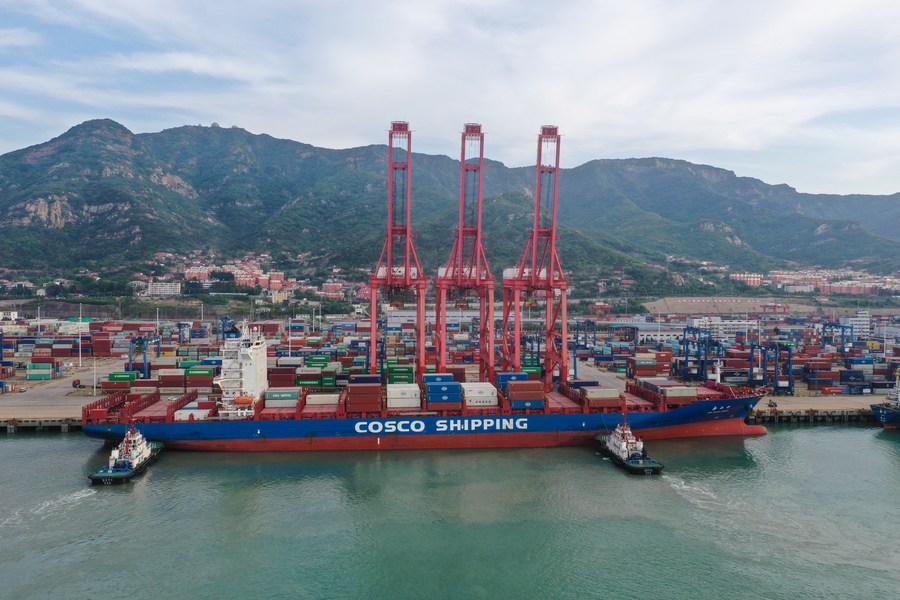Commentary: BRI paves way for peaceful development, common prosperity

This photo taken on Oct. 10, 2023 shows a decorated train at the Chinese-built Padma Bridge Rail Link Project (PBRLP) in Munshiganj, Bangladesh. (Xinhua)
As a key pillar of building a global community with a shared future, the BRI has brought concrete benefits and inspired hope worldwide, and will continue to pave the way for the peaceful development and common prosperity of the world.
BEIJING, Oct. 12 (Xinhua) -- During the past 10 years since the Belt and Road Initiative (BRI) was proposed by China, the wisdom and insight that are at the heart of the initiative have greatly contributed to the peaceful development and common prosperity of the world.
Since its launch, the BRI has evolved from ideas into action, from a vision into reality, and from a general framework into concrete projects. It has been welcomed by the international community both as a public good and a cooperation platform.
According to the white paper titled "The Belt and Road Initiative: A Key Pillar of the Global Community of Shared Future" released on Tuesday, by June 2023, China has signed more than 200 BRI cooperation agreements with more than 150 countries and 30 international organizations across five continents, yielding a number of signature projects and small-scale yet impactful projects.
Over the past decade, BRI cooperation has delivered real gains to participating countries. It has helped to resolve global development challenges, uphold world peace and improve the global governance system.
The BRI has become a catalyst for peaceful development. Faced with huge challenges in the international community, China facilitates world peace and development under the framework of the BRI, without interfering in other countries' internal affairs or playing geopolitical games.

This aerial photo taken on May 9, 2023 shows a port in Lianyungang, east China's Jiangsu Province. In 2013, China proposed the idea of building an "economic belt along the Silk Road" in Kazakhstan, which, combined with the proposal of the 21st Century Maritime Silk Road, eventually became the Belt and Road Initiative (BRI). (Xinhua/Ji Chunpeng)
Through policy communication, infrastructure connectivity, unimpeded trade, financial integration and people-to-people exchanges, the initiative has promoted the joint efforts of countries to safeguard world peace and advance common development. It has become a just way to uphold peaceful development in accordance with the principles of the United Nations.
In war-ravaged Iraq, rebuilding homes and boosting the economy are top priorities. In 2015, China and Iraq signed a cooperation document on jointly promoting BRI cooperation. In recent years, a large number of projects, including a huge power plant in Wasit Province and a sewage treatment plant in Babylon Province, built by Chinese enterprises, have been successfully implemented.
These projects have promoted local economic and social development, and the improvement of people's lives has fundamentally eliminated the root causes of instability, consolidating the security situation that has improved in recent years.
The BRI has brought opportunities for regional peace and stability and created a model for achieving common development, said Abdulla Al Saleh, undersecretary for foreign trade at the United Arab Emirates Ministry of Economy.
The deepening of BRI cooperation has strengthened the driving force for global development and laid a more solid foundation for all countries to pursue common prosperity.
China has hosted the Belt and Road Forum for International Cooperation twice, providing an important platform for participating countries and international organizations to expand exchanges, increase mutual trust and strengthen ties.
The BRI cooperation has also overcome difficulties in infrastructure connectivity and made new progress and breakthroughs in international trade and investment, as well as industrial and financial cooperation.

This aerial photo taken on Feb. 6, 2020 shows the Parapeti Bridge in Santa Cruz, Bolivia. The Parapeti Bridge is one of the four longest bridges of the El Espino-Charagua-Boyuibe Highway project, a flagship project within the framework of the China-proposed Belt and Road Initiative (BRI). (Xinhua/Xin Yuewei)
By the end of June 2023, China has signed agreements on industrial capacity cooperation with more than 40 countries. These countries have expanded cooperation in traditional industries, and explored cooperation in emerging industries.
Meanwhile, China has signed 21 free trade agreements with 28 countries and regions, and a total of 13 Chinese-funded banks have established 145 first-tier offices and branches in 50 BRI partner countries.
In the process of BRI cooperation, China has dispatched more than 2,000 agricultural experts and technicians to over 70 countries and regions, helping reduce rural poverty in Asia, Africa, the South Pacific, Latin America and the Caribbean by developing modern agriculture and increasing farming incomes.
China has also aimed at achieving common prosperity by helping participating countries construct industrial parks and providing guidance for Chinese enterprises to create jobs for locals through high-level industrial cooperation.
The World Bank has estimated that by 2030, BRI-related investment could lift 7.6 million people out of extreme poverty and 32 million out of moderate poverty.
As a key pillar of building a global community with a shared future, the BRI has brought concrete benefits and inspired hope worldwide, and will continue to pave the way for the peaceful development and common prosperity of the world.
Photos
Related Stories
- Beijing abuzz with atmosphere for 3rd Belt and Road Forum
- Official website launched for 3rd Belt and Road Forum for Int'l Cooperation
- Int'l summit in Hong Kong highlights high-quality construction of Belt and Road
- Interview: China ready to elevate BRI economic, trade cooperation to new level: official
- In Numbers: Investment between China and BRI partner countries reaches $380 billion
Copyright © 2023 People's Daily Online. All Rights Reserved.









